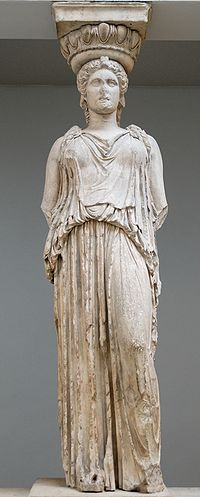- Clothing in ancient Greece
-
 Caryatid wearing chiton from the Erechtheion (British Museum. Note the blousing, or Kolpos, over the Zone.)
Caryatid wearing chiton from the Erechtheion (British Museum. Note the blousing, or Kolpos, over the Zone.)
Clothing in ancient Greece primarily consisted of the chiton, the peplos, himation, and chlamys.
Contents
History and types
While no clothes have survived from this period, descriptions exist from contemporary accounts and artistic depiction. Clothes were mainly homemade, and often served many purposes (such as bedding). Despite popular imagination and media depictions of all-white clothing, elaborate design and bright colors were favored.[1]
The essential clothing for men and women was an inner tunic (peplos or chiton) and outer cloak (himation). The peplos was usually a heavier woollen garment, while the chiton was a lighter linen. Clothes were fastened with brooches or pins (fibulae), and a belt or girdle (zone) might secure the waist. The upper part of the peplos was folded down to the waist to form an apoptygma. Either garment could be pulled up under the belt to blouse the fabric: kolpos. A strophion was an undergarment sometimes worn by women around the mid-portion of the body, and a shawl (epiblema) could be draped over the tunic. Men could don a short cloak (chlamys). Men might wear a hat (petasos), women less commonly, and for outdoors, leather sandals or boots. Greek women wore one large piece of wool or linen, wrapped around them and pinned in various ways to make it stay.
See also
Footnotes
Sources
- Metropolitan Museum: Ancient Greek Dress
- Georgia O'Daniel Baker, Helen R. Pullen, A Handbook of Costume Drawing: A Guide to Drawing the Period Figure for Costume Design Students, 2nd ed. Focal Press, 2000, ISBN 0240804031, 9780240804033
External links
Women
Ancient Greece Periods Geography Politics Rulers - Kings of Sparta
- Kings of Athens
- Archons of Athens
- Kings of Macedon
- Kings of Pontus
- Kings of Paionia
- Roman Emperors
- Kings of Kommagene
- Kings of Lydia
- Attalid Kings of Pergamon
- Diadochi
- Kings of Argos
- Tyrants of Syracuse
Life - Agriculture
- Clothing
- Cuisine
- Democracy
- Economy
- Education
- Festivals
- Homosexuality
- Law
- Marriage
- Mourning ritual
- Olympic Games
- Pederasty
- Philosophy
- Prostitution
- Religion
- Slavery
- Warfare
- Wine
Military - Wars
- Army of Macedon
- Antigonid Macedonian army
- Pezhetairoi
- Hoplite
- Seleucid army
- Hellenistic armies
- Phalanx formation
- Peltast
- Sarissa
- Xyston
- Sacred Band of Thebes
People OthersGroups- Playwrights
- Poets
- Philosophers
- Tyrants
- Mythological figures
CulturesBuildings Arts Sciences Language Writing Lists - Cities in Epirus
- Theatres
- Cities
- Place names
Categories:- History of clothing
- Greek clothing
Wikimedia Foundation. 2010.
